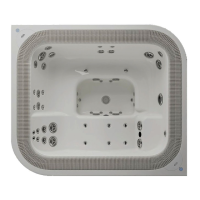14
Q(3, part.EV/EV1) Make provisions for connecting up with
the solenoid valve.
IMPORTANT: The solenoid valve (required for auto-
matic water lling) must be permanently connected
to the water supply via a rigid pipe system.
Q Models with a heat exchanger (
3, parts S/S1) Make pro-
visions for connecting the heat exchanger primary circuit to the
system producing hot water.
QYou can use a garden hose to ll the hot tub.
Any connections to the drinking water supply network
(other than those suggested) must be made in compli-
ance with standard EN1717, adopting anti-pollution
protective met hods “AA”, “AB” or “AD”. For further
information, we recommend you contact your water
supply company and/or your plumber.
CAUTION: (IEC 60335-1) The pressure of the hydraulic
system feeding the equipment must not exceed 600
kPa (6 bar); if the equipment has one or more solenoid
valves for the water supply, the pressure must be mini-
mum 35 kPa (0.35 bar).
Preparing the electrical connections
QThe electrical connection for the hot tub (3, part.E/E1) can
be made as follows:
- single-phase line (220-240V 1~)
- three-phase line consisting of 2 phase conductors + neutral
conductor (380-415V 2N~)
- three-phase line consisting of 3 phase conductors + neutral
conductor (380-415V 3N~)
Q The rated power supply voltage of the equipment is al-
ways 220-240V.
Q The equipment can also be installed in Countries where
the 220-240V voltage is supplied by a two-phase system. For
the connection please refer to the instruction manual.
QThe installer must in any case use properly protected cables
with a suitable cross-section (220-240 V~: min. 4 mm
2
; 380-415
V~: min. 2,5 mm
2
), with characteristics not inferior to type H 05
VV-F.
QModels with heat exchanger Connect the electrical box for
the hot tub with the devices that control the circulation of the
hot water in the primary heat exchanger circuit (see the wiring
diagram, installation manual). For this purpose, there is a termi-
nal (220-240V/16A) in the electrical box to which the circulation
pump or other equivalent device can be connected.
Position the pipes that power the exchanger away
from the electric power supply cable.
Q Models with Jacuzzi® Eco-Heat/CoolPower heat pump:
provide an electric cable for connecting the pump to the electric
box. (for more information, see the documentation provided with
the heat pump).
QProvision of a timer with time switch - "silence" function
This function prevents the automatic start of the pumps (ltering
cycle) and/or the blower; It can therefore help to reduce the noise
present in the environment (e.g. during the night).
Activation takes place via the signal that a timer, or time switch,
sends to the tub electronic box.
When this function is used, it is necessary to prepare a timer
equipped with a normally open contact, to be connected to the
electronic box using a 2x0,75 mm
2
H-05 VV-F type cable.
Refer to the installation manual for the wiring diagram and de-
tails about the operation.
QTo ensure the degree of protection required by the standards
against water splashes, and to make it is easier to connect to
the electrical mains, the electronic control box on the hot tub is
equipped with a M25x1.5mm cable clamp.
Q The cable cross-section measurements must be chosen
according to the system consumption, as well as the cable
routes and distances, the chosen protective systems, and
the specic standards for xed electrical systems in force in
the country where the hot tub is installed.
Q The installer must comply with the above, as well as using wa-
tertight ttings at the junction points, and ensuring compli-
ance with the specic standards for xtures in force in the
country where the hot tub is installed.
You must comply with this last regulation. Any other proce-
dure is prohibited.
Electrical safety
The Jacuzzi® hot tubs are safe appliances, manufactured accord-
ing to EN 60335.2.60, EN 61000 and EN 55014 standards and
tested during production to guarantee user safety.
Q Installation must be carried out by qualied personnel who
are authorised to install the product, in compliance with the na-
tional regulations in force.
It is the installer’s responsibility to select the mate-
rials according to use, carry out the installation cor-
rectly, and verify the condition of the network to
which the appliance will be connected, as well as its
suitability in ensuring usage safety during mainte-
nance and inspection operations.

